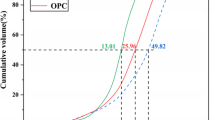Abstract
The investigation of heavy metal leaching and physicochemical properties of cement-solidified waterworks sludge (CMWWS) formed by incorporating waterworks sludge (WWS) into cement mortar was carried out. The chemical composition, compressive strength and other physicochemical properties of the CMWWS cube specimens were determined using field emission scanning electron microscopy (FESEM), X-ray diffractometry (XRD) and Fourier transform-infrared spectroscopy (FTIR). The major type of chemical components present in CMWWS was found to be Al and Fe. The increasing amount of WWS added to cement mortar resulted in the increasing of organic matter, urchin-like morphology and clear peak intensity. At the end of 28 days of curing, the soaking solution became strongly basic and CMWWS cube specimens leached out higher amount of heavy metals. The compressive strength of CMWWS increased up to a WWS percentage of 10%, and basic (pH > 7) curing solution was found to be better than water for curing purposes. It is concluded that solidification–stabilisation (S/S) technique is able to effectively reduce the leaching of heavy metals from the WWS and CMWWS containing up to 10% WWS can be used as construction material.










Similar content being viewed by others
References
Greenwood N N and Earnshaw A 1997 Chemistry of the elements. Oxford: Butterworth Heinemann
Jones P H and Tompeck M A 2006 Water treatment: Encyclopedia of environmental science and engineering, 5th edition, Boca Raton, FL: CRC Press
Maha Alqam, Ahmad Jamrah and Haya Daghlas 2011 Utilization of cement incorporated with water treatment sludge. Jordan J. Civil Eng. 5: 268–277
Victoria A N 2013 Characterisation and performance evaluation of water works sludge as bricks material. Int. J. Eng. Appl. Sci. 3: 69–79
Zaboon S M 2011 Aluminum leachability evaluation from oven dried alum sludge. Iraqi J. Chem. Petrol. Eng. 12: 25–33
Babatunde A O and Zhao Y Q 2007 Constructive approaches toward water treatment works sludge management: An International review of beneficial reuses. Critical Rev. Environ. Sci. Technol. 37: 129–164
Jangkorn S, Kuhakaew S, Theantanoo S, Klinla-or H and Sriwiriyarat T 2011 Evaluation of reusing alum sludge for the coagulation of industrial wastewater containing mixed anionic surfactants. J. Environ. Sci. 23: 587–594
DOE 2005 Environmental Quality Act (Scheduled Waste) Regulation. Department of Environment, Ministry of Natural Resources and Environment Malaysia
Aminnudin M B 2009 Study on characteristic, treatment and disposal of drinking water treatment plant residue. In: Proceedings of Water Malaysia 2009: ICIBP2009 – International Conference on Industry Best Practice, 19–21 May 2009. Kuala Lumpur, Malaysian Water Association (MWA)
Awab H and Paramalinggam T 2011 Mussel shell and waterworks sludge as sorbent materials for the removal of Cu (II) from aqueous solution. J. Fundam. Sci. 7: 113–119
Kayranli B 2011 Adsorption of textile dyes onto iron based waterworks sludge from aqueous solution; isotherm, kinetic and thermodynamic study. Chem. Eng. J. 173: 782–791
Sadri Moghaddam S, Alavi Moghaddam M R and Arami M 2010 Coagulation/flocculation process for dye removal using sludge from water treatment plant: Optimization through response surface methodology. J. Hazard Mater. 175: 651–657
Hovsepyan A and Bonzongo J C 2009 Aluminum drinking water treatment residuals (Al-WTRs) as sorbent for mercury: Implications for soil remediation. J. Hazard Mater. 164: 73–80
Babatunde A O, Kumar J L G and Zhao Y Q 2011 Constructed wetlands using aluminium-based drinking water treatment sludge as P-removing substrate: Should aluminium release be a concern. J. Environ. Monit. 13: 1775–1783
Vesilind P A, Hartman P A and Skine E T 1986 Sludge processing and disposal. Bruce A M, Colin F and Newman P J (eds.) USA Lewis Publishers. pp 170–183 (Chapter 16)
Oladoja N A and AliuY D 2009 Snailo shell as coagulant aid in the alum sludge precipitation of malachite green. J. Hazard Mater. 164: 1496–1502
Ramasamy V and Suresh G 2009 Mineral characterization and crystalline nature of quartz in Ponnaiyar River sediments, Tamilnadu, India. Am-Euras J. Sci. Res. 4: 103–107
Gabrovsek R, Vuk T and Kaucic V 2006 Evaluation of the hydration of Portland cement containing various carbonates by means of thermal analysis. Acta Chim. Slov. 53: 159–165
Zaiton Abdul Majid 2004 Stabilization/solidification of toxic and hazardous waste: Engineering and chemical consideration. Thesis submitted in partial fulfillment of the requirement for the award of Doctor of Philosophy of Universiti Malaya, Malaysia
Acknowledgements
The authors are wish to thank Universiti Teknologi Malaysia for the financial support (Research University Grant, GUP, Q.J130000.7126.01J51) and Zamalah scholarship.
Author information
Authors and Affiliations
Corresponding author
Rights and permissions
About this article
Cite this article
Thanalechumi, P., Mohd Yusoff, A.R., Ponraj, M. et al. Studies on potential of Portland cement mortar for binding of waterworks sludge to reduce heavy metal leaching. Sādhanā 41, 359–367 (2016). https://doi.org/10.1007/s12046-016-0472-0
Received:
Revised:
Accepted:
Published:
Issue Date:
DOI: https://doi.org/10.1007/s12046-016-0472-0




